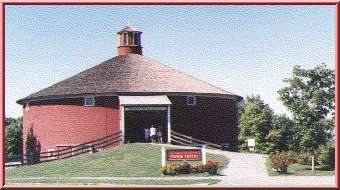"Why a round barn you say"?
One of the most concise explanations was offered by Jackie Dougan Jackson in her book Stories from the Round Barn.

She says that an aerial view of the cow shows it to be
wedge-shaped and therefore arranging these wedges around a circle with the heads closest to the center silo and the wide "business
end" at the outer circumference of the barn represents the most
efficient of space.

The round barn met with particular favor, as the fact that it
permited having the silo centrally located and in this way
minimized feeding labor which strongly appealed to the overworked
mild farmer.

The round barn offered greater convenience in storing, handling
and distributing the feed while much greater strength is secured
with less lumber than is possible in the case of the rectangular
building.
Circular barns ranging from sixty to ninety feet in diameter are
very practical; they would accommodate as many as one hundred
dairy cows with space to spare.

Round barns also provided sufficient room for the hay mows and
granary on the second floor.
The popular supposition that a round barn is difficult to light
is erroneous, in a circular barn and during the winter the sun
can directly shine into some portion of the stable at all hours
of the day.

The essential advantages of the round barn were convenience,
strength, and cheapness.
Either a wooden, brick, or concrete silo is constructed in the
center of the barn, as in this position it is of material
importance as a support to the roof and in addition its central
location minimizes the labor involved in feeding the cattle.

There are still some round barns surviving, and some still in
use. There are about 100 around in Indiana, particularly in the
North East part of the state, and many still in Wisconsin.
This one is "The Shelburne Museum" in Shelburne Vermont.

Another possibility for their construction:
is said to be, the round shape provided no corners for evil
spirits to hide in.
OżO